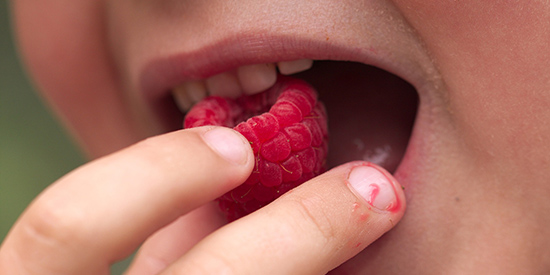Crunch, chew, suck, or squish? Deakin taste experts explore food feel
Media release
Do you prefer a chewy caramel to a soft marshmallow? Or a crunchy nut to melting chocolate? Deakin University's Centre for Advanced Sensory Science (CASS) is working to shed more light on the under-researched area of food texture, and how driving healthier choices might be more about how food feels than how it tastes.
The team are looking at tactile perception in the oral cavity, that is, how our mouth perceives the textures of foods and how it behaves when we're eating.
When it comes to oral behaviour CASS Director Professor Russell Keast said people tend to fall into four groups: crunchers, suckers, chewers, and squishers.
"For most of us it's easy to see which segment we fall into when we think about the things we like to eat," Professor Keast said.
"Crunchers might like chocolate with nuts whereas chewers would prefer a cherry ripe or chewy caramel. Suckers might like something that melts, and squishers might prefer a bar of chocolate with marshmallow inside.
"These tactile preferences, combined with our textural sensitivities, have a huge effect on consumption. They determine why we often reach for certain foods over others and eat much more of them.
"Yet we understand very little of what's happening in the oral cavity, and most of the knowledge we do have is assumed from what we know about touch."
Professor Keast said there was surprisingly little research into this area, but the work he is doing in his lab, alongside international collaborators, is aiming to change that.
"There are three different surfaces in the mouth, the tongue, the hard palate, and the gingiva between the teeth and gums. This is different from fingertips, which only have one surface," he said.
"Little is actually known about how texture is perceived in the mouth. There are three or four different sensors in the mouth some deep, some shallow. We want to find out more about how they work and how they influence our liking of different textures and ultimately our consumption of different foods."
The CASS team are testing sensors in the mouth by using different thicknesses of fibres, and dyes with different textures and lines.
"If you're very sensitive to texture you can determine which way the lines are going when this dye is placed in your mouth," Professor Keast said.
"Another experiment we tried with our international collaborators was placing letters on people's tongues. But we found while some could tell when the letters changed, they couldn’t articulate what the actual letter was. So it seems we can't use our tongues to read just yet.
"It is important to have international collaborators involved as we can start to determine the relationship between textural sensitivity and what kind of foods people like that is consistent across cultures."
Professor Keast said texture was strongly linked to the perceived quality of food, so there was an increasing need from the food industry to get texture right.
"It's also about improving public health. The food industry is being proactive in wanting to reduce problem nutrients like salt, sugar and fat, while maintaining consumer satisfaction," he said.
"Small changes in these ingredients can make a big difference at the population level if they are highly consumed foods.
"A stealth approach is needed and modifying texture is an ideal way of doing that. For example, we can make changes to the structure of food which can increase the perceived quality while reducing problem nutrients, without people knowing what's happening."
Professor Keast said his team's work could also help better understand how infants and young children perceive texture differently, with the aim of changing the textures of some less-preferred foods to expose children to a larger range of tastes.
"At the other end of the age spectrum, a better understanding of texture and oral behaviour could help older people who may have problems with chewing, by manipulating the texture of food to find something that is easy to eat while also texturally appealing," he said.
"All this research is about getting a far greater understanding of the textural qualities and mouth behaviours that are driving our food preferences."
Deakin's Centre for Advanced Sensory Science is hosting a public seminar on Thursday 24 October where attendees can hear from three academics leading international research into food texture. The seminar 'Understanding texture, implications for eating, health and food industries' will be followed by a tour of the CASS laboratories at Deakin's Burwood campus. More event information can be found here.

